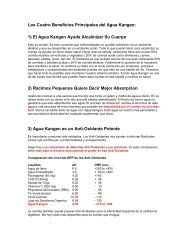ACID-ALKALINE BALANCE: ROLE IN CHRONIC ... - My Kangen Tools
ACID-ALKALINE BALANCE: ROLE IN CHRONIC ... - My Kangen Tools
ACID-ALKALINE BALANCE: ROLE IN CHRONIC ... - My Kangen Tools
Create successful ePaper yourself
Turn your PDF publications into a flip-book with our unique Google optimized e-Paper software.
1866<br />
Tanner and Tanner: Citrate treatment in PKD rats<br />
Table 4. Ammonia handling in six-month-old normal rats and rats with PKD<br />
Normal rats<br />
Rats with PKD<br />
Tap water KCitr Tap water KCitr<br />
(N 5) (N 5) (N 5) (N 5)<br />
Arterial ammonia lmol/L 406 373 32 4 a 354<br />
Renal vein ammonia lmol/L 8411 776 79 19 8417<br />
Cortical P NH3 mm Hg 10 6 476 53 15 339 4812<br />
Ammonia excretion lmol/min 0.740.12 0.400.09 b 0.280.19 c 0.320.07<br />
Ammonia production lmol/min 1.670.23 1.100.26 a 0.770.41 c 1.140.32<br />
Values are means SD.<br />
a<br />
P 0.05, b P 0.01, and c P 0.001 compared with normal rats on tap water<br />
Table 5. Electrolyte handling in six-month-old normal rats and rats with PKD<br />
Normal rats<br />
Rats with PKD<br />
Tap water KCitr Tap water KCitr<br />
Plasma [K ] mEq/L 3.700.30 (9) 2.910.45 (8) b 4.040.56 (8) 3.340.17 (7) d<br />
Excreted K lEq/min 1.590.16 (9) 2.950.48 (8) c 1.780.28 (8) 3.160.29 (7) f<br />
FE K % 264 (9) 516 (8) c 6416 (8) c 478 (7) d<br />
Plasma [calcium] mg/100 mL 8.600.24 (6) 8.010.37 (4) a 8.640.24 (3) 8.470.33 (4)<br />
Excreted calcium lg/min 0.620.32 (9) 0.360.12 (6) 1.100.59 (6) 0.740.26 (8)<br />
Cortex [calcium] mg/kg wet weight 954 (6) 17689 (3) a 1538 (3) a 18128 (3)<br />
Medulla [calcium] mg/kg wet weight 15621 (6) 855677 (3) c 22237 (3) 1001462 (3) e<br />
Plasma [phosphate] mg/100 mL 4.970.34 (10) 5.370.67 (9) 8.701.45 (9) c 6.040.61 (7) f<br />
Values are means SD (number of animals). Kidney data are for the left kidney.<br />
a<br />
P 0.05, b P 0.01, and c P 0.001 compared with normal rats on tap water<br />
d<br />
P 0.05, e P 0.01 and f P 0.001 compared with rats with PKD on tap water<br />
renal failure develop secondary hyperparathyroidism, and PKD may provide an explanation for increased citrate<br />
parathyroid hormone promotes release of citrate from excretion. A high level of citrate in proximal tubule cells<br />
bone and elevates the plasma citrate concentration [11]. would diminish the driving force for reabsorption of filtered<br />
In normal rats, plasma citrate was not affected by the<br />
citrate across the luminal cell membrane and in<br />
level of chronic intake (Table 3). Likewise, patients on this way could lead to increased citrate excretion [20].<br />
long-term intake of potassium citrate do not show an Although the tenfold higher rate of citrate excretion<br />
increase in serum citrate concentration [23].<br />
in rats with PKD compared with normal rats is most<br />
Tissue citrate. The elevated renal cortical tissue citrate impressive (Table 3), it is important to note that only<br />
levels in untreated rats with PKD (Table 3 and Fig. 3) 1% of the filtered load is excreted by the normal rat<br />
could be due to both an increase in intracellular citrate kidney. Fractional excretion of citrate in the untreated<br />
concentration and/or an increase in the tubular fluid or rat with PKD, 23% (Table 3), is similar to fractional<br />
urine citrate level. It appears to be mainly due to an excretion of citrate in the normal human kidney, about<br />
increase in intracellular level, since urine concentrations 10 to 35% [20]. Excessive urinary excretion of citrate in<br />
of citrate were elevated in the KCitr-treated rats and yet the rat with PKD may contribute to the development of<br />
tissue citrate levels were not increased in these animals metabolic acidosis, since loss of citrate represents a loss<br />
(Table 3).<br />
of potential bicarbonate.<br />
Many factors can influence renal tissue citrate levels, Citrate consumption. Citrate is an important metabolic<br />
including intracellular pH, citrate production or consumption,<br />
substrate in the kidneys, accounting for about 10%<br />
or altered citrate transport by luminal and of their energy production [22, 24, 25]. In untreated rats<br />
peritubular cell membrane carriers [20]. Although we with PKD, renal citrate consumption was lower than<br />
cannot say why the tissue citrate level was increased in normal (Table 3). Decreased GFR and consequent decreased<br />
rats with PKD, the finding of Ogborn et al that tissue<br />
tubular sodium reabsorption in cystic kidneys<br />
succinate levels are low suggests impaired mitochondrial probably contributes to the decreased citrate consumption,<br />
metabolism of citrate [8].<br />
although we cannot rule out an intrinsic defect in<br />
Citrate reabsorption and excretion. High urine citrate citrate utilization.<br />
concentration and elevated citrate excretion in rats with Citrate and PKD. Citrate handling by cystic kidneys<br />
PKD was first reported by Ogborn et al [8]. Our finding is clearly abnormal. It is still not obvious, however, why<br />
that renal cortical tissue citrate is elevated in rats with citrate treatment is beneficial. Had we known before



